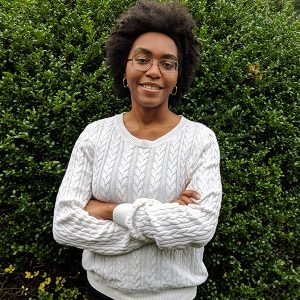
The more crowded the neighborhood, the more social the bird. Such are the findings of an interspecies study by Fordham College at Rose Hill junior Lindsay Thomas.
Thomas, who is majoring in biology and minoring in sociology, unveiled her research at the Sixth Annual Bronx Science Consortium Poster Symposium on Wed., Oct. 3. Her work focused on observing birds, and how humans interact with them, in New York City parks. She hypothesized that birds live in different “avian communities” across the city, and, just like their human counterparts, their behavior often reflects the environment of their neighborhood.
In crowded parks, like Central Park, Thomas found that birds and humans interacted closely. People could get close to birds before the birds would take off and seek refuge in nearby woods—and not even that far into the woods. In less crowded parks, like Pelham Bay Park in the Bronx, birds flew away much sooner when people approached them, and they fled much deeper into the wooded areas.
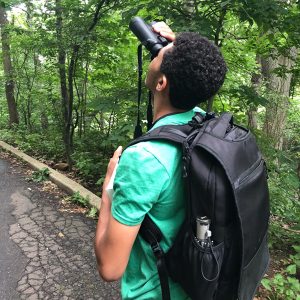
“In Central Park the birds are competing for the same areas of the park as humans so they tend to hang out in areas such as footpaths and fountains,” said Thomas. “Unfortunately, birds also tend to use humans as easy food sources due to frequent hand feeding.”
Thomas wasn’t alone in tracking bird-human observations; she was supported by New York City high school students recruited for the study through Project TRUE (Teens Researching Urban Ecology), a program funded by the National Science Foundation that pairs teens with educators from the Wildlife Conservation Society and Fordham researchers.
One of the students, Angel Torres, riffed on Thomas’ work. Out in the field he noticed that birds were more vocal in crowded parks where they were competing with humans and city noise; they were less vocal in quieter parks. However, regardless of the park, when the same species of bird was observed in close proximity to others of the same species, vocalization rates increased.
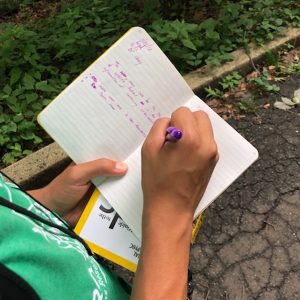
Thomas’ groundwork for the research began after Tiffany House, her counselor from CSTEP (Fordham’s Collegiate Science, Engineering, and Technology Program), encouraged her to apply for a summer research internship with Project TRUE. As Thomas lives in Rockland County, CSTEP funded her housing for the internship.
Through the Wildlife Conservation Society, she was matched with Jocelyn Harrison, a conservation educator from Central Park who helped her iron out research methods and questions. She was also mentored by Fordham graduate student Emily Casper. By July, she was explaining research methods to three teens and working in the field gathering data with them.
Observing her own mentors opened up new possibilities for Thomas.
“It was great seeing people who were more along in their careers, like Jocelyn. I didn’t know that her job even existed,” she said of the conservation educator. “And I didn’t know we had such a diverse graduate program in biology until I met Emily. Her research is in marine biology! I thought you had to go somewhere else to study that.”
After college, Thomas hopes to pursue fellowship opportunities. Her interests lie at the intersection of policy, public health, and the sciences.
And as inspired as she was by her mentors, Thomas was also inspired by her mentees.
“One of the major takeaways,” she said, “was just working with the high school students and seeing how smart and driven they were.”
Thomas said she went to a low-income high school where budget cuts led to reduction of advanced placement classes.
“When I started this program, my main goal was to provide the students with guidance that I didn’t have at their age,” she said. “If I heard they were interested in college, I would be really on to it and encourage them.” Last month one of the students sent her a college essay to read.
“I tried to offer support beyond the program, support that I didn’t get,” she said.
]]>Fordham University students gathered in the Schiff Family Great Hall to take part in the 4th Annual Bronx Science Consortium Poster Symposium. The event was a presentation of student research on the high school, undergraduate, graduate, and post-doctoral levels.
“What is really so great about this symposium is the diversity of the projects,” said Ron Jacobson, Ph.D., associate vice president in the Office of the Provost and one of the event’s organizers. “It shows all the interests of our students and the many things the consortium has to offer.”
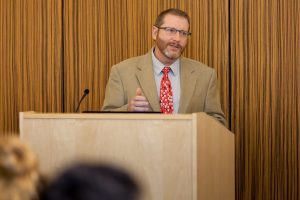
(Photos by Oscar Masciandaro)
J. Alan Clark, Ph.D., associate professor of biology and an avian expert, shared his doctoral study on penguin vocalizations. He documented the calls of feeding and mating Spheniscus penguins and tested the penguins’ responses to the calls.
He also gave the students important advice:
“Look for something that interests you, and when you see something weird, question it. There’s a wonderful world to explore, so always keep exploring,” he said, adding in jest they should “become rich and famous” as well.
Project TRUE Students Chasing Opportunity
One of the groups of high school students from Fordham’s Project TRUE (Teens Researching Urban Ecology) presented a project on what kind of small mammals live within the Zoo’s enclosure.
The project is the result of a $2.6 million grant Fordham received with the Wildlife Conservation Society in order to teach and train local high school students in ecology and other STEM subjects.
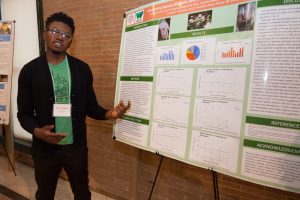
The study discovered seven species of mammals that roam free within the zoo, the most prominent being white-footed mice.
“Everyone was so welcoming. I come from a small school where there’s not a lot of interest in stuff like this,” said Stephanie Blackwood of North Salem High School. “It’s great that I got to meet kids my age who are interested in the same subjects.”
“It was much better than sitting at a desk all summer,” added Anye Frimpong, of the Bronx Academy of Software Engineering. “I got to try something new. It makes me want to pursue a liberal arts education.”
HPV Research and the Benefits of Catnip
Fordham undergraduate and graduate students were also in attendance.
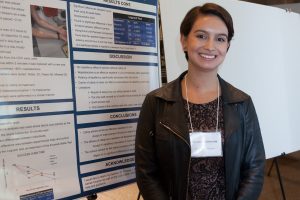
Fordham senior Victoria Sieverson’s project addressed the positive benefits of catnip for humans. In her study, she tested the effectiveness of pantolactone, an active ingredient in catnip, as a repellent against black-legged ticks.
“The catnip was effective in repelling the ticks away from human skin for about two hours. When I eventually come back to this project, I want to increase the concentration levels to see if I can get it to last longer,” said Sieverson.
(The ingredient, she said, has no negative side effects on cats.)
Jacqueline Heffner, a Rose Hill junior majoring in physics, discovered a way to detect the presence of the HPV virus without long, drawn out tests.
By creating a microsphere, she was able to decipher whether the virus was present based on shifts in the air’s frequency near the sphere’s edge. By testing for HPV infections this way instead of using biosensors, Heffner believes that diagnosis and treatment can begin more quickly.
“In developing countries, instead of wasting time taking tests and sending them miles away to a facility to get results, doctors can take samples and test the frequency right where they are,” said Heffner. “It speeds up the process and allows those who need help to get it faster.”
In all, some two dozen posters were presented. The projects were created in conjunction with the Bronx Science Consortium, an educational partnership of five Bronx institutions that focuses on bringing together science research and intellectual support from its partners.
–Mary Awad
]]>Four members of the consortium—Fordham, The New York Botanical Garden, The Bronx Zoo, and Montefiore Health System—have teamed up for a series of programs and events dedicated to educating others about the concept of a “healthy planet, healthy people.”
The first event will be an April 12 lecture at Fordham’s Lincoln Center campus, “Celebrating the Legacy of Jane Jacobs: A Conversation with Greg Lindsay.” Jacobs was responsible for leading the successful opposition to the construction of the Lower Manhattan Expressway, which would have run along Canal Street. The University will also host talks by science writer Carl Zimmer and Eric W. Sanderson, landscape ecologist for the Wildlife Conservation Society at the Bronx Zoo. Zimmer speaks on April 21 at the Flom Auditorium in the William D. Walsh Family Library. Sanderson speaks on April 26 in the same venue.
Sanderson’s lecture on April 26 is an example of the collaboration between the zoo, which offers complimentary general admission to all NYC undergraduate college student, and Fordham.
The zoo will host a three-day long Earth Fair on April 22, which will include interactive exhibits such as a Carbon Footprint app that lets visitors figure out their own carbon footprint, a discussion about the amazing conservation success story of the rebound of the wild population of white rhinos, and a staging of Reusable the Musical.
John Calvelli, executive vice president of Public Affairs for the Wildlife Conservation Society, said that the partnership has inspired the zoo to consider new ways to reach out to the Bronx community. One initiative he said they’re exploring is providing free passes during the month to children who get their checkups with their doctors at Montefiore.
“By coordinating efforts and planning activities together, we strengthen the links between these vital neighborhood institutions and new ideas are born through collaboration,” he said.
The weekend of April 22 will see a flurry of activity at Montefiore and at the New York Botanical Garden as well. The hospital will host an Earth Day celebration on April 21, and on April 22, the Garden will host tours, a composting bin-making workshop and a screening of the 2013 documentary Seeds of Time, which follows an agriculturalist who is building a biological archive to maintain crop diversity.
For more information, visit the Bronx Science Consortium event page.
]]>The discussion, which takes places from 2 to 4 p.m. at the Mertz Library Reading Room, is being presented by the garden’s Humanities Institute, which was established in the spring of 2014 as a way to bridge the divide between the arts and sciences, and bring together scholarship relating to nature, landscape, and the built environment.
It will feature:
J. Alan Clark, Ph.D., associate professor of conservation biology, who will detail how he uses radar, acoustic recordings, and flight tunnels to explore bird migration through urban landscapes in a talk titled, “Bird Migration Through Urban Landscapes;”
Sheila Foster, Albert A. Walsh Professor of Law and Faculty, and co-director of the Urban Law Center at Fordham School of Law, who will explore the urban commons framework as a concept for developing cities that are both revitalized and inclusive in a talk titled “The City as a Common Good;” and
Roger Panetta, visiting professor of history, who will detail how the renewal of the Brooklyn waterfront has caught the attention of politicians, planners and the public here and abroad, and drawn a remarkable concentration of civic energy to the water’s edge, in a talk titled “Whose Waterfront?”
Vanessa Bezemer Sellers, humanities research program coordinator at the NYGB, said the topic is important because the natural environment of cities is being damaged in a myriad of ways in the service of economic interests.
“If a neighboring building is demolished, and it becomes a temporary green spot or a community garden, it’s nilly-willy just taken away for development. Money is always still number one, and that becomes a very serious issue because there’s simply too little space and too much stress [on]human dignity,” she said.
This is the first time a Fordham contingent will speak at the institute. The University and the NYBG pledged to work together more closely in 2012, when both joined the Bronx Science Consortium.
Sellers said she hoped the colloquium, which will consist of panelists speaking for 10 minutes followed by 90 minutes of open discussion, might inspire Rose Hill campus-based students to cross Southern Boulevard more often.
“I see students [jog]around the perimeter here. I thought well, if they run here, it would be nice to have them come on a regular basis and build a rapport with the professors, so that our green environment becomes a regular part of the program of incoming students,” she said.
To RSVP for the colloquium, visit the Humanities Institute’s event page.
]]>The annual Bronx Summit on Technology Innovation and Start Ups explores the opportunities and challenges underlying the Bronx’s potential for technology-based innovation and startup activity. Sponsored by the Center for Digital Transformation, the summit—which is now in its fourth year—focuses on leveraging existing resources in the borough to promote economic development.
“The Bronx has good infrastructure, it’s relatively low-cost, and yet nobody focuses that much on it,” said the center’s director Wullianallur “RP” Raghupathi, PhD, professor of information systems.“Through these conferences, we want to build up the skills and the knowledge base we already have here to promote economic and technological development… and make it attractive for entrepreneurial and business activities.”
The summit is free and open to the public, but RSVP is required.
This year’s theme, “Opportunistic Growth for the Bronx in Technology: Next Step—Is the Bronx Up to the Challenge?”, pays special attention to health care technology. Speakers and panelists will discuss innovative solutions such as hosting health hackathons in which students and other programmers collaborate on building mobile applications.
Examples of what could arise from a health hackathon are remote monitoring for diabetics and “telemedicine” web conferencing for doctors and patients, Raghupathi said. But first the borough must tap into the brainpower within its borders.
“We have all these institutions, colleges, and this support from the borough president’s office as well as private entities,” he said, referencing Bronx Community College, St. Barnabas and Montefiore hospitals, the Bronx Science Consortium, and the South Bronx Development Corporation, among others. “We felt that we needed to act as an interface among these various stakeholders.”
Fordham presenters include Rosemary Wakeman, PhD, director of the urban studies program; Nisha Mistry, director of the Urban Law Center; and Carey Weiss, sustainability initiatives coordinator for the Social Innovation Collaboratory.
The summit is co-sponsored by Fordham’s urban studies program, the Urban Law Center, and the Bronx Technology Innovation Coalition (BITC).
For more information, contact Raghupathi or Center for Digital Transformation senior fellow Teresita Abay-Krueger.
]]>Office of the Provost
The 2010-2011 Annual Report for the Office of the Provost highlights the accomplishments of the academic units of the University and provides a detailed account of the state of the schools. It lays the foundation for achieving the academic priorities of the provost for the 2011-2012 academic year, which emphasize the vision for a global curriculum, partnerships (in particular, the development of a Bronx Science Consortium), academic programming, academic financial planning, and faculty capacity and research, among others.

During its first year of operations, the Office of the Provost implemented the initial phase of integrated academic budget planning, focusing on the alignment of resources with the University’s mission, strategic goals, and assessment. It also supported the successful completion of the Middle States Periodic Review Report, which highlights assessment of student learning outcomes and mission integration at all levels of academic planning. The Office of the Provost and the academic departments also made significant progress on a broad range of initiatives supporting the University’s strategic vision articulated in Toward 2016, which focus on academic rigor and quality. Though the University pursues academic excellence for its own sake, one intended effect of these efforts is for Fordham to rank in the top 25 nationally in U.S. News & World Report’s “America’s Best Colleges” rankings. The 2012 edition ranks Fordham at 53, an improvement from 56 in 2011 and significantly, an improvement from 84th place in 2002.
]]>